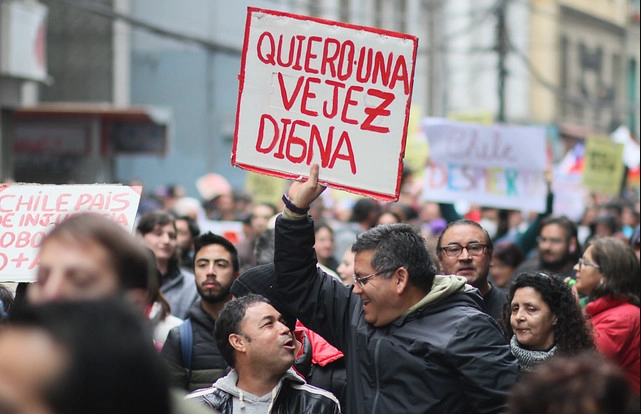On January 24, the reform of the Chilean pension system was discussed in the Chamber of Deputies. After long deliberation, the Chamber approved and passed the second constitutional procedure in the Senate, the bill that creates a new mixed pension system.
The bill was submitted to Congress by the President of the Republic, Gabriel Boric, this past January 7 to deliberate the creation of a mixed pension system. That is a system with contributions from the state, employers, and workers. This type of initiative is not new in the Chilean context, since for more than a decade several public policy proposals and bills to modify the pension system adopted at the end of 1980 have been submitted.
It should be remembered that the current system replaced the so-called distribution system: a system in which the sum of workers’ contributions and fiscal contributions went to a common fund destined to pay life-long pensions. Since then, workers (except the Armed Forces, which have their own pension scheme) are obliged to contribute 10% of their income and taxable income to their individual capitalization account, which is managed by a Pension Fund Administrator (AFP).
Although the bill was approved in general, several of the core aspects were not approved. The first change is the increase in individual capitalization: from 10% to 10.5% of the taxable remunerations and income. The second is the additional contribution of 6% of taxable remunerations to be paid by the employer. Half (3%) of this additional charge would be used to strengthen the worker’s contribution. The other half (3%) would be used to finance the social insurance that includes actions such as guarantee with intergenerational solidarity, third-party care supplement, and compensation for differences in life expectancy.
The vote on this point was very close, 76 votes in favor and 75 against. The qualified quorum required in Chile for social security regulations is 78 votes. The deputies against belong to the Republican Party, Independent Democratic Union, and National Renewal, among others. The 6% increase can be seen on the one hand as an overvaluation of labor, but on the other hand, as the capacity for future consumption and increased demand for goods and services.
There is an imperative need to correct or modify the Chilean pension system structurally. The current subdivision of funds, from higher to lower risk: A, B, C, D, E, in which pensions are invested, seems to have reduced rather than increased the capital of contributors.
According to the CENDA Foundation (Center for National Alternative Development Studies), when analyzing the profitability of the quota value (unit of measurement that expresses the value of each fund) of the PFAs, there was positive profitability that coincided with that experienced by the stock markets from 1981 to 1997. But as a result of the 1997 Asian crisis, they experienced a sharp fall that lasted until 2003 when they recovered to their 1997 level. Since then, it has stagnated.
According to the same foundation, another aspect to consider is the commissions and premiums charged by the Pension Fund Administrators, which greatly reduce the capital contributions made by members and the Treasury, generating pensions that do not cover the needs of retirees.
The table below presents a summary of the performance of the funds from 2018 to 2023, showing the real positive or negative profitability. As can be seen, the results subject to market conditions are variant, having even negative returns in the lowest-risk fund (fund E). Two considerations must be considered. First, people diversify products, so the overall result may be negative. Second, the fact that a positive sign appears does not imply high returns for the fund, only that it is above zero.
Table 1. Real Profitability of Pension Funds
| Year | Fund | ||||
| A | B | C | D | E | |
| 2023 | + | + | – | – | – |
| 2022 | – | – | + | + | + |
| 2021 | + | + | – | – | – |
| 2020 | + | + | + | + | + |
| 2019 | + | + | + | + | + |
| 2018 | – | – | – | + | + |
Source: Elaborated with information from the Superintendency of Pensions. Represents the accumulated return in 12 months: January to December of each year.
These data reinforce the argument for supporting the capitalization of workers. It is not about having more money to spend when they retire, it is about being able to have a dignified and carefree retirement. According to Report 67 of the Superintendency of Pensions, 57% of people withdrew capital from their pension funds as a way out of the economic problems caused by the COVID-19 pandemic. Along the same lines, close to 3.8 million people (35% of the total) who withdrew capital were left without pension savings.
Given that total withdrawals were concentrated in the 25-55 age group, a future decline in pension income of 24-39% is expected. If serious measures are not taken, a large part of the population leaving the labor market in the next 15 years could find themselves in a condition of economic vulnerability.
We do not have to go very far. Currently, a good part of the pensioners in Chile receive pensions that are below the poverty line. A palliative solution is the Universal Guaranteed Pension (PGU) which complements incomes. However, this solution is still the responsibility of the state and taxpayers.
Why not generate a system that contributes to Chileans where 3% + 3% = 6%, and thus break with intergenerational poverty in the country?
*Translated by Janaína Ruviaro da Silva from the original in Spanish.











